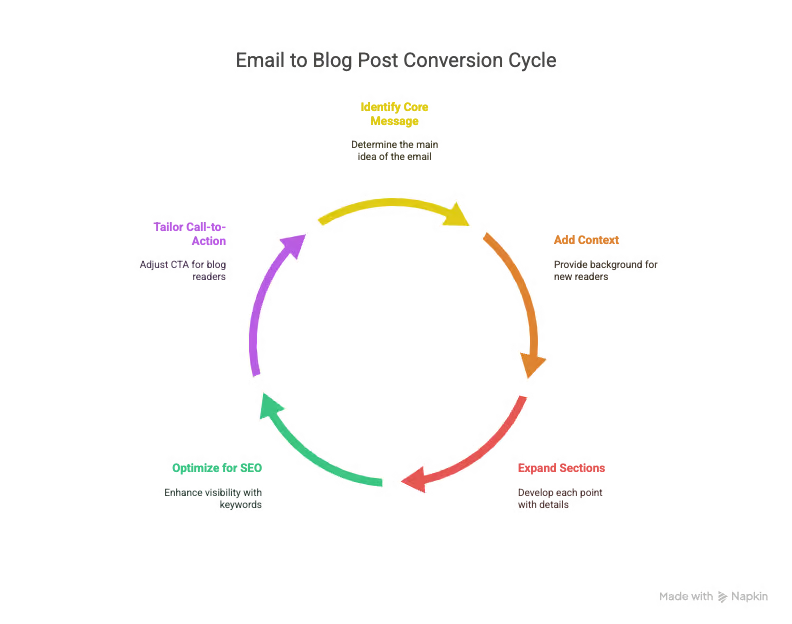
You’ve crafted the perfect email. Clicks are coming in. Conversions look solid. But what happens after the send?
Most emails have a short shelf life. That’s a missed opportunity.
With a few smart adjustments, you can repurpose your highest-performing email content into SEO-friendly blog posts that bring in long-term traffic, and keep working long after your campaign is over.
Here’s how to do it, step by step, but first let's talk about why.
Email marketing is built on clarity and intent. Every word is purposeful, and the content has already been tested against real user behavior. This gives you a head start when it comes to creating blog posts that perform.
Email content provides:
Instead of brainstorming from zero, you’re building on content that’s already demonstrated value.
Curious how strategic campaigns are built from scratch? Here’s a look at the process.
Look for emails that:
Avoid messages that are purely promotional or time-sensitive, unless you can generalize the content.
Still unsure where to start? Scan your analytics. Look for emails with the highest open or click-through rates. Those are often strong candidates. If you don’t have metrics handy, start with welcome emails, FAQ-style messages, or anything that’s educational. These tend to be evergreen, easy to expand, and useful to both new and returning readers.


What is the main idea or problem the email addresses? That becomes your blog post topic. It also helps inform your target keyword.
Emails are written for people who already know you. Unlike email, blog posts must speak to readers who may be finding you for the first time. Start with a strong hook and a short explanation of what the post will cover.
Emails are often short by design. Blog posts can go deeper. Take each key point from the email and add context, examples, supporting data, or visuals. Break it into sections using clear H2 and H3 headings.
If your email shared “3 tips for better onboarding,” turn each tip into its own section. Add examples, cite supporting data, and layer in your voice to expand the value.
Do basic keyword research using tools like Google Keyword Planner or SEMrush. Integrate those keywords naturally into your headers, text, and image alt tags. Add internal links to related content and external links to support your claims.
The CTA in an email might drive a direct sale or booking. In a blog post, your reader might need a different next step. Consider inviting them to read more, download a related guide, or join your email list.
Repurposing email content into blog articles creates value on multiple levels:
Repurposing also saves creative energy. Instead of staring at a blank page, you’re building from something proven. You’re not just writing more; you’re writing smarter.
This approach also supports content strategy across platforms. The same ideas can be adapted for social media, lead magnets, or video scripts.
Behind the scenes, technical factors like inbox placement and list quality also affect your performance. This deliverability guide walks through best practices for staying out of spam folders.
If you utilize email automation or onboarding flows, consider viewing these emails as a series. Each message can be transformed into an individual blog post, or collectively compiled into a comprehensive resource like a downloadable guide or cornerstone article.
This kind of repurposing is especially effective for building internal link structures and showing topic authority in your niche.
You don’t need more ideas. You just need to stretch the value of what’s already working.
Your email content is already optimized for clarity and engagement. With the right structure, keywords, and positioning, it can become a core part of your SEO strategy too. Start with what’s already proven to resonate. Then expand it, refine it, and build long-term visibility from content you’ve already created.
Gavin Hewitson was a touring stand-up comedian from 2018 until 2023. While he would argue that he was hilarious, the audience sizes would beg to differ. As a way of making money on the side, Gavin worked as a part-time email marketer with his touring buddy. Believe it or not, the arts do not pay as well as the B2B email marketing service industry (who knew). As time went on, the part-time work grew and grew until a team had to be formed to help support the workload. Thus, In-box was born. Since then, In-box has grown from a one-man band to a team of six, helping e-commerce businesses across the world ranging from New Zealand all the way to Canada with their email and SMS marketing.